Full Text Searchable PDF User Manual
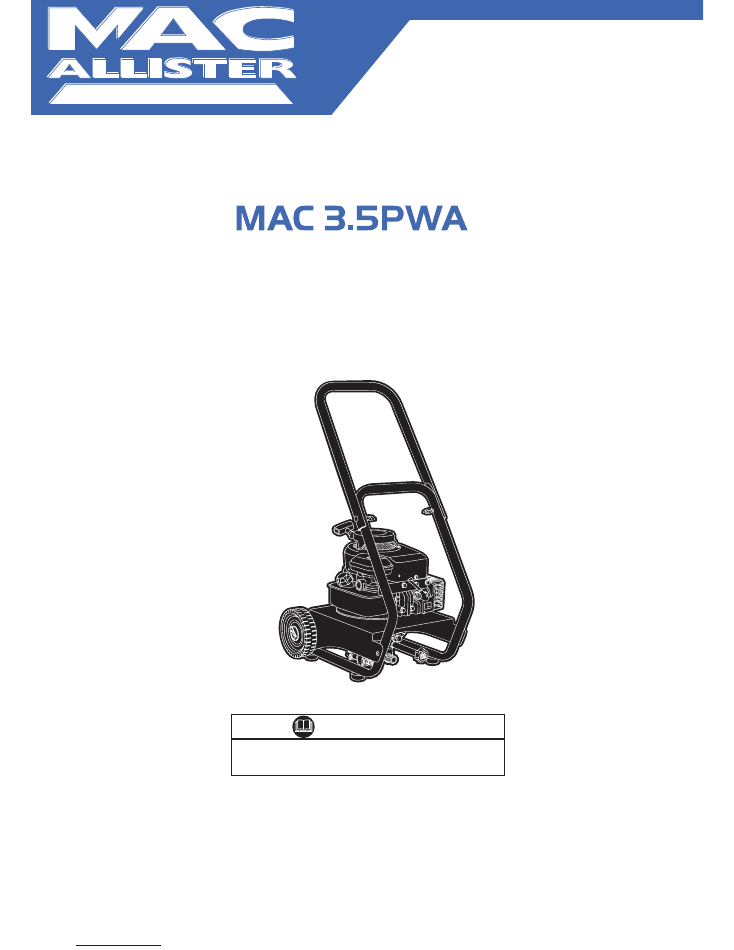
Model No. 020271-0 (1800 PSI Pressure Washer) Manual No. 199291GS Revision 1 (2/20/2006)
Upright Pressure Washer
Operator’s Manual
Questions? Help is just a moment away!
Call your technical helpline at
0845 300 2577
.
Before using this product, read this manual and
follow all Safety Rules and Operating Instructions.
WARNING
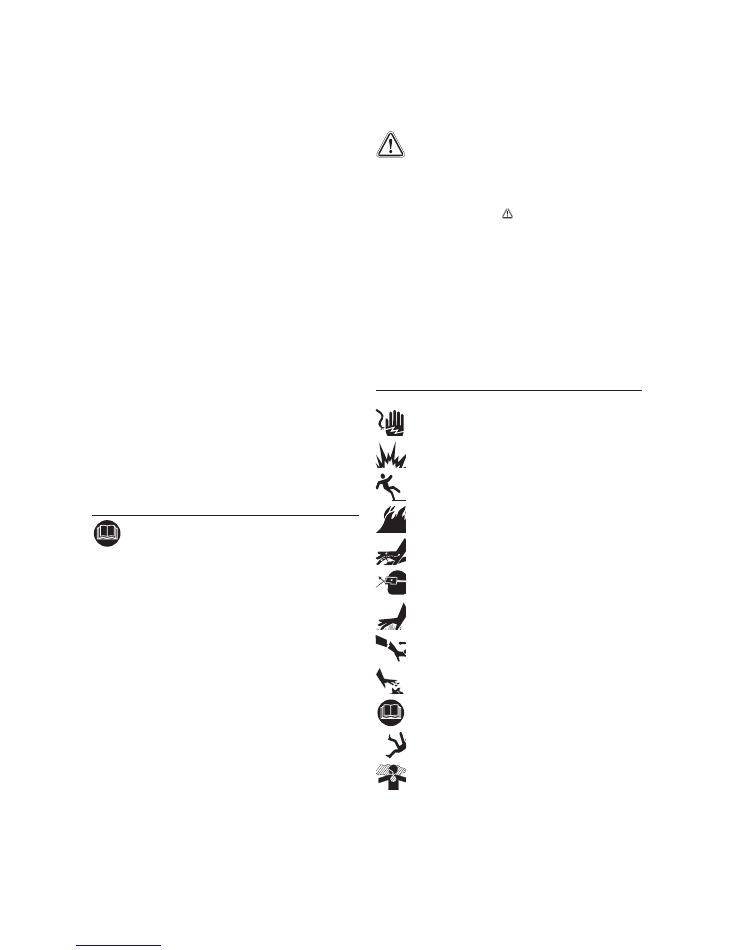
2
SAVE THESE INSTRUCTIONS
CONTENTS
I - Product Specifications . . . . . . . . . . . . . . . . . . . . .2
II - Safety Rules . . . . . . . . . . . . . . . . . . . . . . . . . . . .2
III - Know Your Pressure Washer . . . . . . . . . . . . . .5
IV - Assembly . . . . . . . . . . . . . . . . . . . . . . . . . . . . .6
V - Operation . . . . . . . . . . . . . . . . . . . . . . . . . . . . . .8
VI - Maintenance . . . . . . . . . . . . . . . . . . . . . . . . . .11
VII - Storage . . . . . . . . . . . . . . . . . . . . . . . . . . . . .13
VIII - Troubleshooting . . . . . . . . . . . . . . . . . . . . . .14
IX - CE Declaration and Warranty . . . . . . . . . . . . .15
I - PRODUCT
SPECIFICATIONS
Outlet Pressure
. . . . . . . . . . . . . 125 bar (1800 psi)
Flow Rate
. . . . . . . . . 7.5 liters per minute (2.0 gpm)
Detergent
. . . . . . . . . . . . . .Use detergent approved
for pressure washers
Water Supply
. . . . . . . Not to Exceed 37ºC (100°F)
Temperature
Automatic Cool
. . . . Will cycle when water reaches
Down System
51-68°C (125°-155°F)
Measured LwA
. . . . . . . . . . . . . . . . . .100 dB(A)/pW
Guaranteed LwA
. . . . . . . . . . . . . . . .100 dB(A)/pW
Sound Pressure Level @ 7m
. . . . . . . . . .75 dB(A)
Shipping Weight
. . . . . . . . . . . . . . .24.5 kg (54 lbs.)
Equipment Description
Read this manual carefully and become
familiar with your pressure washer. Know its
applications, its limitations and any hazards
involved.
Thank you for purchasing this Mac Allister product.
We are confident that this product will meet and
exceed your expectations for quality and reliability.
Please take the time to carefully read this entire
manual before using your new pressure washer and
take note of the safety precautions contained herein
and marked on the product.
This manual contains information for a pressure
washer that operates at 124 BAR at a flow rate of
450 liters per hour. This high quality residential
system features 12.7 CM (5 IN) wheels, an axial
cam pump with stainless steel pistons, an automatic
cool down system, a chemical injection system, and
an adjustable spray nozzle. Includes safety goggles,
heavy duty 7.2 M (25 FT) hose, and more.
II - SAFETY RULES
This is the safety alert symbol. It is used to
alert you to potential personal injury
hazards. Obey all safety messages that
follow this symbol to avoid possible injury
or death.
The safety alert symbol (
) may be used with a
signal word (WARNING, CAUTION), a pictorial or a
safety message to alert you to hazards.
WARNING
indicates a hazard which, if not avoided,
could
result
in death or serious injury.
CAUTION
indicates a
hazard which, if not avoided,
might
result in minor or
moderate injury.
CAUTION
, when used
without
the
alert symbol, indicates a situation that could result in
equipment damage. Follow safety messages to
avoid the hazard or reduce the risk of injury or
death.
Hazard Symbols and Meanings
Electrical Shock
Explosion
Fall
Fire
Fluid Injection
Flying Objects
Hot Surface
Kickback
Moving Parts
Read Operator’s Manual
Slippery Surface
Toxic Fumes
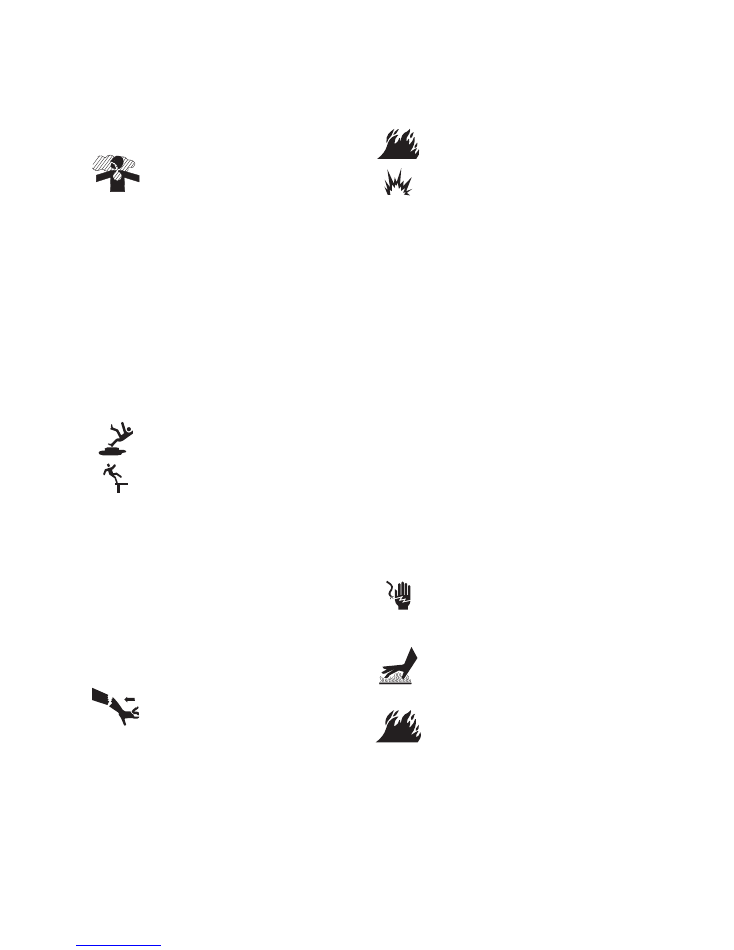
3
WARNING
Running engine gives off carbon
monoxide, an odorless, colorless, poison
gas.
Breathing carbon monoxide can cause
nausea, fainting or death.
Some chemicals or detergents may be
harmful if inhaled or ingested, causing
severe nausea, fainting or poisoning.
• Operate pressure washer ONLY outdoors.
• Keep exhaust gas from entering a confined area
through windows, doors, ventilation intakes or other
openings.
• Do not operate pressure washer inside any building or
enclosure, even if doors or windows are open.
• Use a respirator or mask whenever there is a chance
that vapors may be inhaled.
• Read all instructions with mask so you are certain the
mask will provide the necessary protection against
inhaling harmful vapors.
Use of pressure washer can create
puddles and slippery surfaces.
High pressure spray could cause you to
fall if you are too close to the cleaning
surface.
• Keep spray nozzle between 20 to 60 CM (8 to 24 IN)
away from cleaning surface.
• Operate this unit on a stable surface.
• The cleaning area should have adequate slopes and
drainage to reduce the possibility of a fall due to slippery
surfaces.
• Be extremely careful if you must use the pressure
washer from a ladder, scaffolding or any other relatively
unstable location.
• Firmly grasp spray gun with both hands when using high
pressure spray to avoid injury when gun kicks back.
Rapid retraction of starter cord (kickback)
will pull hand and arm toward engine
faster than you can let go.
Broken bones, fractures, bruises or
sprains could result.
• ALWAYS point gun in safe direction and squeeze spray
gun trigger, to release pressure and avoid kickback
each time, before starting engine. Engage trigger lock
when not in use.
• When starting engine, pull cord slowly until resistance is
felt and then pull rapidly to avoid kickback.
• After each starting attempt, where engine fails to run,
always point gun in safe direction and squeeze spray
gun trigger to release high pressure.
• Firmly grasp spray gun with both hands when using high
pressure spray to avoid injury when gun kicks back.
Petrol and its vapors are extremely
flammable and explosive.
Fire or explosion can cause severe burns
or death.
WHEN ADDING PETROL
• Turn pressure washer OFF and let it cool at least
2 minutes before removing gas cap.
• Fill petrol tank outdoors.
• DO NOT overfill tank. Allow space for petrol
expansion.
• Keep petrol away from sparks, open flames, pilot
lights, heat, and other ignition sources.
• DO NOT light a cigarette or smoke.
WHEN OPERATING EQUIPMENT
• DO NOT tip engine or equipment at angle which causes
petrol to spill.
• DO NOT spray flammable liquids.
WHEN TRANSPORTING OR REPAIRING
EQUIPMENT
• Transport/repair with petrol tank EMPTY or with petrol
shutoff valve OFF.
WHEN STORING PETROL OR EQUIPMENT WITH
PETROL IN TANK
• Store away from furnaces, stoves, water heaters,
clothes dryers or other appliances that have pilot light or
other ignition source because they can ignite petrol
vapors.
Spray contact with electrical wiring can
result in electrocution.
• Keep water spray away from electric wiring or fatal
electric shock may result.
Running engines produce heat.
Temperature of muffler and nearby areas
can reach or exceed 65°C (150°F).
Severe burns can occur on contact.
Exhaust heat/gases can ignite
combustibles, structures or damage petrol
tank causing a fire.
• Do not touch hot surfaces and avoid hot exhaust gases.
• Allow equipment to cool before touching.
• Keep at least 1.5 M (5 FT) clearance on all sides of
pressure washer including overhead.
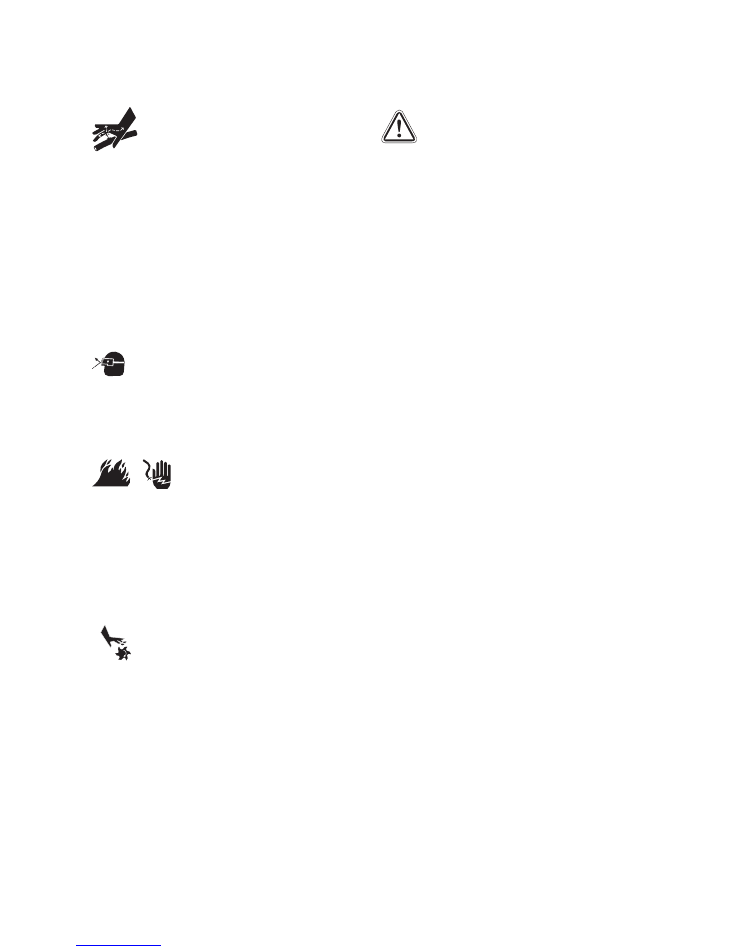
4
The high pressure stream of water that this
equipment produces can pierce skin and
its underlying tissues, leading to serious
injury and possible amputation.
Spray gun traps high water pressure, even
when engine is stopped and water is
disconnected, which can cause injury.
• NEVER aim spray gun at people, animals or plants.
• DO NOT allow CHILDREN to operate pressure washer.
• NEVER repair high pressure hose. Replace it.
• NEVER repair leaking connections with sealant of any
kind. Replace o-ring or seal.
• Keep high pressure hose connected to pump and spray
gun while system is pressurized.
• ALWAYS point gun in safe direction and squeeze spray
gun trigger, to release high pressure, every time you
stop engine. Engage trigger lock when not in use.
High pressure spray can cause paint chips
or other particles to become airborne.
• Always wear safety goggles when using this equipment
or in vicinity of where equipment is in use.
• Before starting the pressure washer, be sure you are
wearing adequate safety goggles.
Unintentional sparking can result
in fire or electric shock.
WHEN ADJUSTING OR MAKING REPAIRS TO
YOUR PRESSURE WASHER
• Disconnect spark plug wire from spark plug and place
wire where it cannot contact spark plug.
WHEN TESTING FOR ENGINE SPARK
• Use approved spark plug tester.
• Do not check for spark with spark plug removed.
Starter and other rotating parts can
entangle hands, hair, clothing, or
accessories.
• DO NOT wear loose clothing, jewelry or anything that
may be caught in the starter or other rotating parts.
• Tie up long hair and remove jewelry.
CAUTION
Excessively high or low operating speeds
increase risk of injury and damage to
pressure washer.
• DO NOT tamper with governed speed.
• DO NOT operate pressure washer above rated
pressure.
A pressure washer produces a high pressure spray
which increases risk of injury and damage to unit.
• DO NOT secure spray gun in open position.
• DO NOT leave spray gun unattended while machine is
running.
• NEVER use a spray gun which does not have a trigger
lock or trigger guard in place and in working order.
• Always be certain spray gun, nozzles and accessories
are correctly attached.
CAUTION
High pressure spray may damage fragile items
including glass.
• DO NOT point spray gun at glass when in jet spray
mode.
• NEVER aim spray gun at plants.
Improper treatment of pressure washer can damage it
and shorten its life.
• NEVER operate units with broken or missing parts, or
without protective housing or covers.
• DO NOT by–pass any safety device on this machine.
• Before starting pressure washer in cold weather, check
all parts of the equipment to be sure ice has not formed
there.
• NEVER move machine by pulling on hoses. Use handle
provided on unit.
• Check petrol system for leaks or signs of deterioration,
such as chafed or spongy hose, loose or missing
clamps, or damaged tank or cap. Correct all defects
before operating pressure washer.
• This equipment is designed to be used with authorized
parts only. If equipment is used with parts that DO NOT
comply with minimum specifications, user assumes all
risks and liabilities. Call the technical helpline at
0845 300 2577 for information.
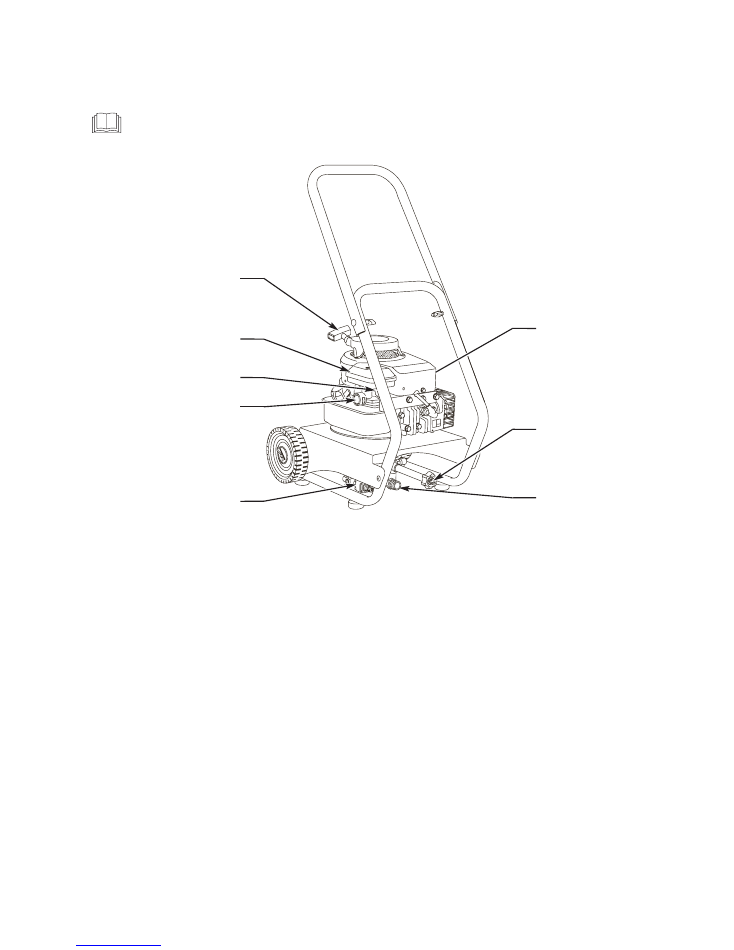
5
III - KNOW YOUR PRESSURE WASHER
Read this operator’s manual and safety rules before operating your pressure washer.
Compare the illustrations with your pressure washer to familiarize yourself with the locations of various
controls and adjustments. Save this manual for future reference.
A - Oil Fill/Dipstick
— Check and fill with oil here.
B - Water Inlet
— Connection for garden hose.
C - High Pressure Outlet
— Connection for high
pressure hose.
D - Pump
— Develops high pressure. Equipped with
Automatic Cool Down System.
E - Primer Bulb
— Prepares a cold engine for
starting.
F - Throttle Control Lever
— Sets engine in
starting mode for recoil starter and stops a running
engine.
G - Air Filter
— Protects engine by filtering dust and
debris out of intake air.
H - Recoil Starter
— Used for starting the engine
manually.
Adjustable Nozzle
(not shown) — Always attached
to nozzle extension. Adjustable nozzle allows you to
adjust spray pressure and spray pattern.
Automatic Cool Down System
— Cycles water
through pump when water reaches 52°C-68°C
(125º-155°F). Warm water will discharge from pump
onto ground. This system prevents internal pump
damage.
Chemical Injection Siphon/Filter
(not shown) —
Use to siphon detergent or other pressure washer
chemicals into the low pressure stream.
Data Tag
(not shown, near rear of base plate) –
Provides model and serial number of pressure
washer. Please have these readily available if calling
for assistance.
High Pressure Hose
(not shown) — Connect one
end to water pump and the other end to spray gun.
Spray Gun
(not shown) — Controls the application
of water onto cleaning surface with trigger device.
Includes trigger lock.
F
C
D
A
H
E
G
B
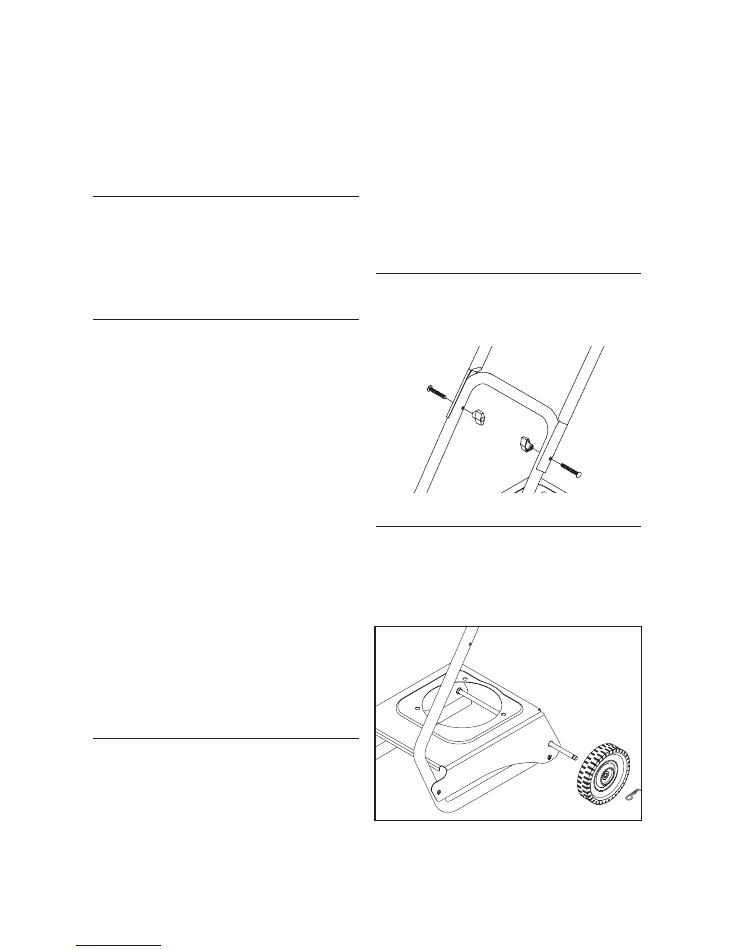
IV - ASSEMBLY
IMPORTANT
: Read entire operator’s manual before
you attempt to assemble or operate your new
pressure washer.
Remove Pressure Washer from
Carton
1. Set the carton on a rigid flat surface.
2. Remove everything from carton except pressure
washer.
3. Open carton completely by slicing each corner
from top to bottom. Use the flattened carton as a
clean, dry assembly surface.
Carton Contents
Items in the carton include:
•
Main Unit
•
Handle
•
High Pressure Hose
•
Spray Gun
•
Adjustable Nozzle Extension
•
Accessory Storage Bag
•
Axle
•
Wheel Kit (includes the following):
•
Wheels (2)
•
Retaining Pins (2)
•
Handle Fastening Hardware Kit (includes):
•
Carriage Bolts (2)
•
Plastic Knobs (2)
•
Parts Bag (includes the following):
•
Operator’s Manual
•
Engine Operator’s Manual
•
Safety Goggles
•
Maintenance Kit
•
Hose Fittings (2)
•
High Pressure quick connect fittings (2)
Preparing Pressure Washer for
Use
If you have any problems with the assembly of your
pressure washer or if parts are missing or damaged,
call the technical helpline at 0845 300 2577. If
calling for assistance, please have the model,
revision, and serial number from the data tag
available.
To prepare your pressure washer for operation,
you will need to perform these tasks:
1. Attach handle to main unit.
2. Install wheel kit.
3. Add oil to engine crankcase.
4. Add petrol to petrol tank.
5. Connect high pressure hose to spray gun and
pump.
6. Connect water supply to pump.
7. Attach nozzle extension to spray gun.
Attach Handle
1. Place handle onto base. Make sure holes in
handle align with holes on base. Insert carriage
bolts through holes from outside of unit and
attach a plastic knob from inside of unit.. Tighten
by hand.
Install Wheel Kit
The wheel kit is designed to greatly improve the
portability of your pressure washer.
NOTE
: Wheel kit is not intended for over-the-road
use.
Refer to Figure 1 and install the wheel kit as
follows:
6
Figure 1
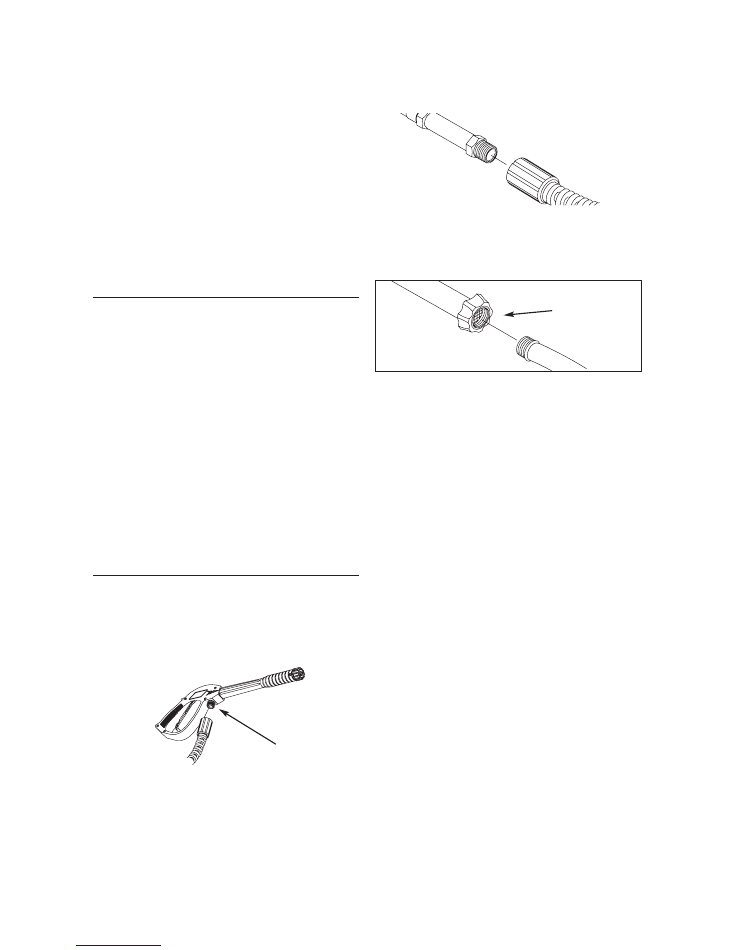
1. Place bottom of pressure washer frame on a
flat, even surface. Temporarily place unit on
blocks to ease assembly.
2. Slide axle through holes in frame, as shown in
Figure 1.
3. Slide a wheel over the axle.
NOTE
: Be sure to install wheel with raised hub
inboard.
4. Retain wheel on axle stud with retaining pin.
See Figure 1.
5. Repeat step 3 and 4 to secure second wheel.
6. Remove temporary blocks.
Add Engine Oil and Petrol
• Place pressure washer on a level surface.
• Damage to equipment resulting from failure to
follow this instruction will void warranty.
• Refer to engine operator’s manual and follow oil
and petrol recommendations and instructions.
NOTE
: Check oil often during engine break–in.
Refer to engine operator’s manual for
recommendations.
CAUTION
: Any attempt to crank or start the engine
before it has been properly filled with the
recommended oil will result in equipment failure.
• Refer to engine manual for oil and petrol fill
information.
• Damage to equipment resulting from failure to
follow this instruction will void warranty.
Connect Hose and Water Supply to
Pump
IMPORTANT
: To avoid pump damage, you must
assemble the nozzle extension to the spray gun and
attach all hoses before you start the engine.
1. Uncoil high pressure hose and attach one end
of hose to base of spray gun. Tighten by hand.
NOTE
: Remove and discard all pump shipping caps
before attaching hoses.
2. Attach other end of high pressure hose to high
pressure outlet on pump. Tighten by hand.
3. Before connecting garden hose to water inlet,
inspect inlet screen (Figure 2). Clean screen if it
contains debris or have it replaced if damaged.
DO NOT run pressure washer if inlet screen is
damaged.
4. Run water through your garden hose for
30 seconds to flush out any debris.
IMPORTANT
: Do Not siphon standing water for the
water supply. Use ONLY cold water (less than 38°C
/ 100°F).
5. Connect the garden hose (not to exceed 15 M /
50 FT in length) to the water inlet.Tighten by
hand (Figure 2).
CAUTION
: There MUST be at least three meters of
unrestricted garden hose between the pressure
washer inlet and any flow shut off device, such as a
‘Y’ shut-off connector or other convenience-type
water shut-off valve.
• Damage to equipment resulting from failure to
follow this instruction will void warranty.
NOTE
: This unit is equipped with a 14MM and a
20MM hose adapter. If using either adapter, obtain a
suitable hose clamp to secure the hose to the
adapter.
6. Turn ON water, point gun in a safe direction and
squeeze trigger to purge pump system of air
and impurities.
WARNING
: High pressure spray can cause paint
chips or other particles to become airborne.
• Always wear safety goggles when using this
equipment or in vicinity of where equipment is in
use.
• Before starting the pressure washer, be sure you
are wearing adequate safety goggles.
7
Figure 2
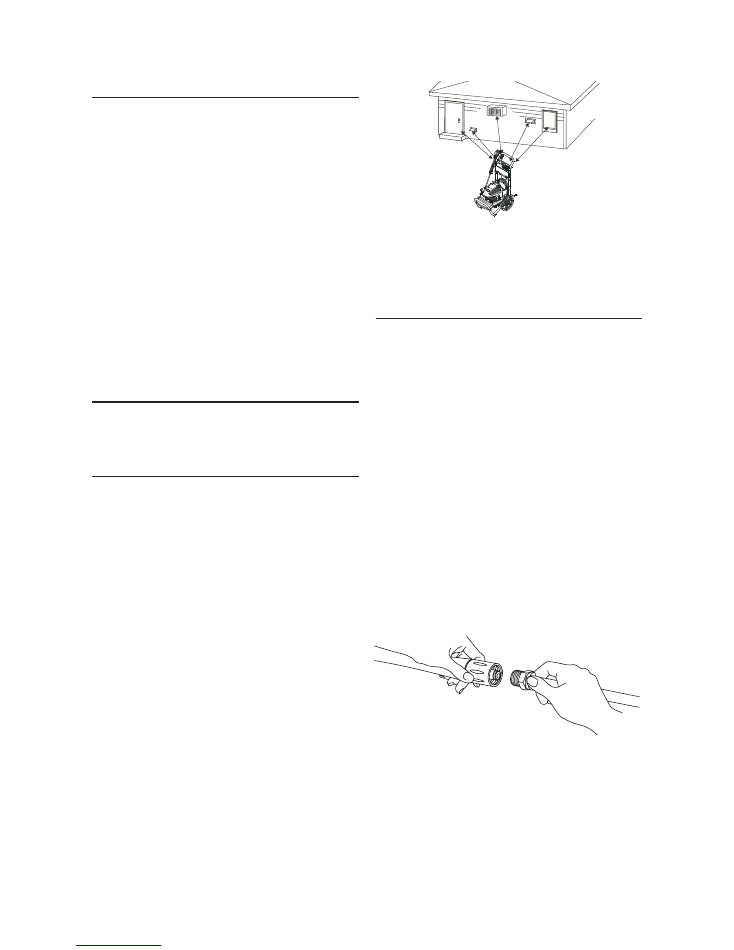
8
Checklist Before Starting Engine
Review the unit’s assembly to ensure you have
performed all of the following.
1. Make sure handle is in place and secure.
2. Check that oil has been added to proper level in
the engine crankcase.
3. Add proper fuel to fuel tank.
4. Check for properly tightened hose connections.
5. Check to make sure there are no kinks, cuts, or
damage to high pressure hose.
6. Provide a proper water supply at an adequate
flow.
7. Be sure to read “Safety Rules” and “How To Use
Your Pressure Washer” before using pressure
washer.
V - OPERATION
HOW TO USE YOUR PRESSURE
WASHER
If you have any problems operating your pressure
washer, please call the technical helpline at
0845 300 2577
.
Pressure Washer Location
Pressure Washer Clearance
WARNING
: Exhaust heat/gases can ignite
combustibles, structures or damage petrol tank
causing a fire.
• Keep at least 150 CM (5 FT) clearance on all
sides of pressure washer including overhead.
Place pressure washer outdoors. Do not place
pressure washer where exhaust gas could
accumulate and enter inside or be drawn into a
potentially occupied building.
WARNING
: Running engine gives off carbon
monoxide, an odorless, colorless, poison gas.
Breathing carbon monoxide will cause nausea,
fainting or death.
• Operate pressure washer ONLY outdoors.
• Keep exhaust gas from entering a confined area
through windows, doors, ventilation intakes or
other openings.
• Do not operate pressure washer inside any
building or enclosure.
Ensure exhaust gas is kept away from any windows,
doors, ventilation intakes or other openings that can
allow exhaust gas to collect in a confined area.
Prevailing winds and air currents should be taken
into consideration when positioning pressure washer.
How to Start Your Pressure Washer
To start your pressure washer for the first time,
follow these instructions step-by-step. This starting
information also applies if you have let the pressure
washer sit idle for at least a day.
1. Place pressure washer near an outside water
source capable of supplying water at a flow rate
greater than 11 L (3.0 GA) per minute and no
less than 1.4 BAR (20 PSI) at pressure washer
end of garden hose.
2. Check that high pressure hose is tightly
connected to spray gun and pump. See
“Preparing Pressure Washer for Use” for
illustrations.
3. Make sure unit is in a level position.
4. Connect garden hose to water inlet on pressure
washer pump.
5. Turn ON water, point gun in a safe direction and
squeeze trigger to purge pump system of air and
impurities.
6. Attach adjustable nozzle extension to spray gun.
Tighten by hand.
7. Position nozzle in low pressure mode (see “How
to Use the Adjustable Nozzle”) and squeeze
trigger on spray gun to relieve air pressure
caused by turning ON water. Water will flow out
of spray gun in a thin stream.
Typical Pressure
Washer Shown

CAUTION
: DO NOT run the pump without the water
supply connected and turned on.
• Damage to equipment resulting from failure to
follow this instruction will void warranty.
8. Continue to hold trigger until there is a steady
stream of water and no air remains in system.
This will make it easier to pull start engine.
Release trigger.
9. Engage trigger lock on spray gun trigger.
10. When starting engine, position yourself as
shown here and start engine according to
instructions given in engine operator’s manual.
Also see operating instructions tag located on
the pressure washer.
WARNING
: Rapid retraction of starter cord
(kickback) will pull hand and arm toward engine
faster than you can let go. Broken bones, fractures,
bruises or sprains could result.
• ALWAYS point gun in safe direction and squeeze
spray gun trigger, to release pressure and avoid
kickback each time, before starting engine.
• When starting engine, pull cord slowly until
resistance is felt and then pull rapidly to avoid
kickback.
• After each starting attempt, where engine fails to
run, always point gun in safe direction and
squeeze spray gun trigger to release high
pressure.
• Firmly grasp spray gun with both hands when
using high pressure to avoid injury when gun kicks
back.
NOTE
: Always keep the throttle lever in the “Fast”
position when operating the pressure washer.
WARNING
: Running engines produce heat.
Temperature of muffler and nearby areas can reach
or exceed 65°C (150°F).
Severe burns can occur on contact.
Exhaust heat/gases can ignite combustibles,
structures or damage petrol tank causing a fire.
• Do not touch hot surfaces and avoid hot exhaust
gases.
• Allow equipment to cool before touching.
• Keep at least 150 CM (5 FT) clearance on all
sides of pressure washer including overhead.
How to Stop Your Pressure
Washer
1. Let engine idle for two minutes.
2. Turn engine off according to instructions given in
engine operator’s manual.
3. ALWAYS point gun in a safe direction and
squeeze spray gun trigger to release retained
high water pressure.
WARNING
: The high pressure stream of water that
this equipment produces can pierce skin and its
underlying tissues, leading to serious injury and
possible amputation.
Spray gun traps high water pressure, even when
engine is stopped and water is disconnected, which
can cause injury.
• Keep high pressure hose connected to pump and
spray gun while system is pressurized.
• ALWAYS point gun in safe direction and squeeze
spray gun trigger, to release high pressure, every
time you stop engine. Engage trigger lock when
not in use.
IMPORTANT
: Spray gun traps high water pressure,
even when engine is stopped and water is
disconnected.
4. Engage trigger lock on spray gun when not in
use.
How to Use Adjustable Nozzle
You should now know how to
START
and
STOP
your pressure washer. The information in this
section will tell you how to adjust the spray pattern
and to apply detergent or other cleaning chemicals.
CAUTION
: A pressure washer produces a high
pressure spray which increases risk of injury and
damage to unit.
• NEVER adjust spray pattern when spraying.
• NEVER put hands in front of nozzle to adjust
spray pattern.
9
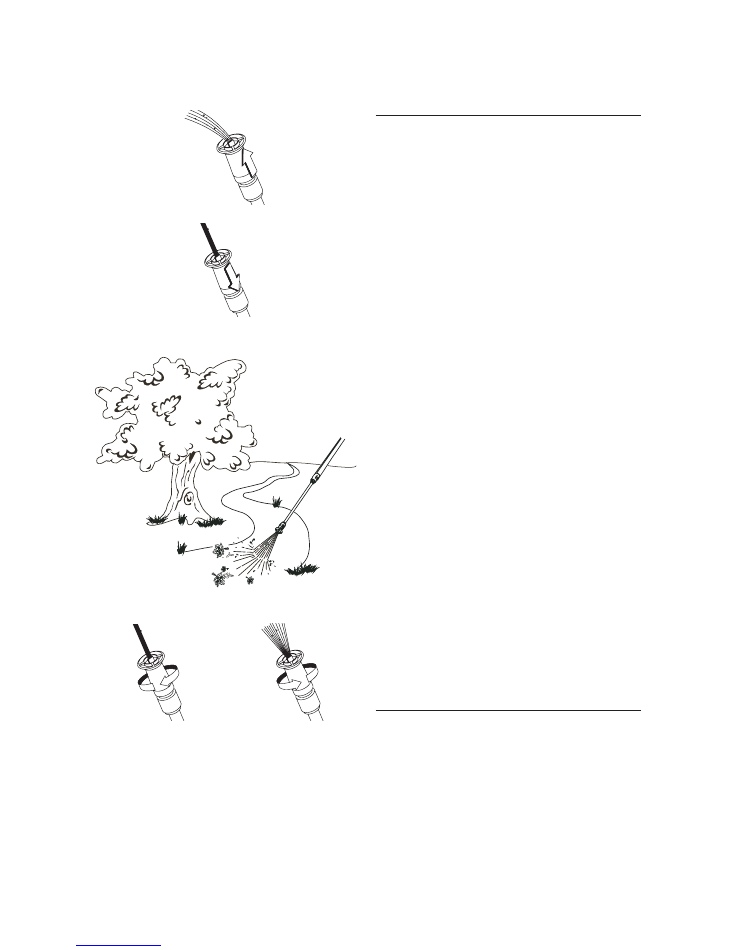
1. Slide nozzle forward when you wish to adjust
spray to low pressure mode.
2. Slide nozzle backward to achieve high pressure.
3. Point nozzle down towards a firm surface and
press trigger to test pattern.
4. Twisting nozzle adjusts spray pattern from a
narrow pattern to a fan pattern.
Usage Tips
• For most effective cleaning, keep spray nozzle
from 20 to 60 CM (8 to 24 IN) away from cleaning
surface.
• If you get spray nozzle too close, especially using
high pressure mode, you may damage surface
being cleaned.
• Do Not get closer than 15 CM (6 IN) when
cleaning tires.
Applying Detergent with
Adjustable Nozzle
IMPORTANT: Use soaps designed specifically for
pressure washers.
Household detergents could
damage the pump.
CAUTION
: You must attach all hoses before you
start the engine.
• Starting the engine without all the hoses
connected and without the water turned ON will
damage the pump.
• Damage to equipment resulting from failure to
follow this instruction will void warranty.
To apply detergent, follow these steps:
1. Review use of adjustable nozzles.
2. Prepare detergent solution as required by job.
3. Place filter end of detergent siphoning tube into
detergent container.
CAUTION
: Keep the detergent siphoning tube from
coming in contact with the hot muffler.
• When inserting the filter into a detergent solution
bottle, route the tube so as to keep it from
inadvertently contacting the hot muffler.
4. Slide adjustable nozzle forward to low pressure
mode. Detergent cannot be applied with nozzle
in high pressure position.
5. Make sure garden hose is connected to water
inlet. Check that high pressure hose is
connected to spray gun and pump. Start engine.
6. Apply detergent to a dry surface, starting at
lower portion of area to be washed and work
upward, using long, even, overlapping strokes.
7. Allow detergent to "soak in" for 3-5 minutes
before washing and rinsing. Reapply as needed
to prevent surface from drying. DO NOT allow
detergent to dry on (prevents streaking).
IMPORTANT:
You must flush the chemical injection
system after each use by placing the filter into a
bucket of clean water, then run the pressure washer
in low pressure for 1-2 minutes.
Pressure Washer Rinsing
For Rinsing:
1. Slide the nozzle backward to high pressure,
press the trigger and wait for the detergent to
clear.
NOTE
: You can also stop detergent from flowing by
simply removing detergent siphoning tube from
chemical container.
10
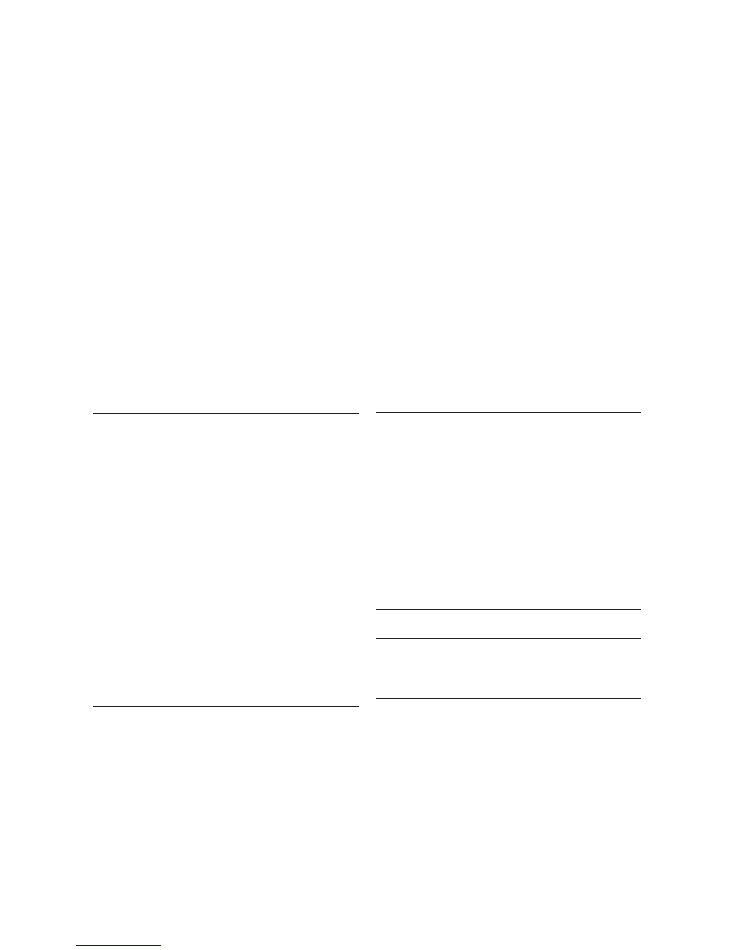
11
2. Keep the spray gun a safe distance from the
area you plan to spray.
WARNING
: High pressure spray could cause you to
fall if you are too close to the cleaning surface.
• Keep spray nozzle between 20 to 60 CM (8 to
24 IN) away from cleaning surface.
• Operate this unit on a stable surface.
• Be extremely careful if you must use the pressure
washer from a ladder, scaffolding or any other
relatively unstable location.
• Firmly grasp spray gun with both hands when
using high pressure spray to avoid injury when
gun kicks back.
3. Apply a high pressure spray to a small area,
then check the surface for damage. If no
damage is found, it is okay to continue cleaning.
4. Start at the top of the area to be rinsed, working
down with same overlapping strokes as you
used for washing and applying detergent.
Cleaning Detergent Siphoning
Tube
If you used the detergent siphoning tube, you must
flush it with clean water before stopping the engine.
1. Place detergent siphoning tube filter in a bucket
full of clean water.
2. Engage trigger lock on spray gun.
3. Slide adjustable nozzle forward to low pressure
position.
4. Flush for 1-2 minutes.
5. Shut off engine.
6. ALWAYS point gun in a safe direction and
squeeze spray gun trigger to release retained
high water pressure.
IMPORTANT
: Simply shutting off the engine will not
release pressure in the pump/hose/spray gun.
After
the engine has stopped, squeeze spray gun
trigger to relieve pressure trapped in the system.
Automatic Cool Down System
(Thermal Relief)
If you run the engine on your pressure washer for
3-5 minutes without pressing the trigger on the spray
gun, circulating water in the pump can reach
temperatures above 52°C (125°F). The system
engages to cool the pump by
discharging the
warm water onto the ground.
VI - MAINTENANCE
The pressure washer warranty does not cover items
that have been subjected to operator abuse or
negligence. To receive full value from the warranty,
the operator must maintain the pressure washer as
instructed in this manual.
NOTE:
Should you have questions about replacing
components on your pressure washer, please the
technical helpline at
0845 300 2577
.
• Some adjustments will need to be made
periodically to properly maintain your pressure
washer.
• All maintenance in this manual and the engine
owner’s manual should be made at least once
each season.
• Once a year you should check the spray gun and
adjustable nozzle extension assembly for wear.
Also clean or replace the spark plug and clean or
replace the engine air filter. Please refer to engine
operator’s manual for more details.
Before Each Use
1. Check engine oil level.
2. Check water inlet screen for damage.
3. Check in-line filter for damage.
4. Check high pressure hose for leaks.
5. Check detergent siphoning tube and filter for
damage.
6. Check spray gun and adjustable nozzle
extension assembly for leaks.
7. Rinse out garden hose to flush out debris.
PRESSURE WASHER
MAINTENANCE
Check and Clean Inlet Screen
Examine the screen on the water inlet. Clean it if the
screen is clogged or replace it if screen is damaged.
Check High Pressure Hose
The high pressure hose can develop leaks from
wear, kinking, or abuse. Inspect the hose each time
before using it.
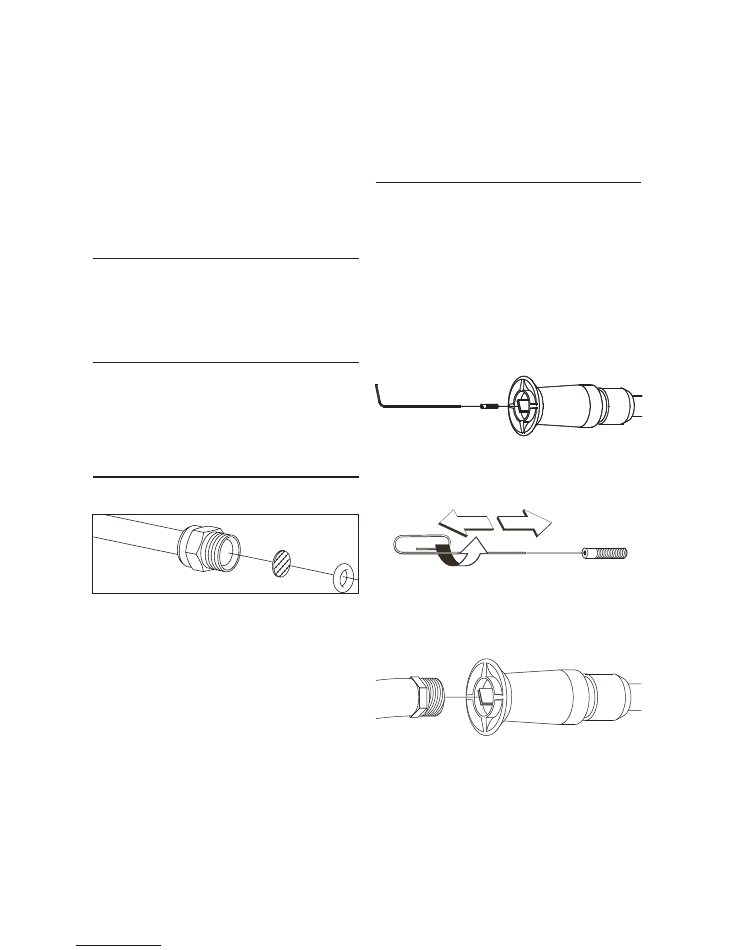
WARNING
: The high pressure stream of water that
this equipment produces can pierce skin and its
underlying tissues, leading to serious injury and
possible amputation.
• NEVER repair high pressure hose. Replace it.
• Replacement hose rating MUST exceed maximum
pressure rating of unit.
Check for cuts, leaks, abrasions or bulging of cover,
damage or movement of couplings. If any of these
conditions exist, replace the hose immediately.
Check Detergent Siphoning Tube
Examine the filter on the detergent tube and clean if
clogged. The tube should fit tightly on the barbed
fitting. Examine the tube for leaks or tears. Replace
the filter or tube if either is damaged.
Check Gun and Adjustable Nozzle
Extension
Examine the hose connection to the spray gun and
make sure it is secure. Test the trigger by pressing it
and making sure it “springs back” into place when
you release it. Put the trigger lock in the ON position
and test the trigger. You should not be able to press
the trigger.
Check In-Line Filter
Refer to Figure 3 and service the in-line filter if it
becomes clogged, as follows:
1. Detach spray gun and nozzle extension from
high pressure hose. Detach nozzle extension
from spray gun and remove o-ring and screen
from nozzle extension. Flush screen, spray gun,
and nozzle extension with clean water to clear
debris.
2. If screen is damaged, o-ring kit contains a
replacement in-line filter screen and o-ring. If
undamaged, reuse screen.
3. Place in-line filter screen into threaded end of
nozzle extension. Direction does not matter.
Push screen in with eraser end of pencil until it
rests flat at bottom of opening. Take care to not
bend screen.
4. Place o-ring into threaded end of nozzle
extension. Push o-ring snugly against in-line
filter screen.
5. Assemble nozzle extension to spray gun, as
described earlier in this manual.
Nozzle Maintenance
A pulsing sensation felt while squeezing the spray
gun trigger may be caused by excessive pump
pressure. The principal cause of excessive pump
pressure is a orifice clogged or restricted with
foreign materials, such as dirt, etc. To correct the
problem, immediately clean the orifice using the
tools included with your pressure washer and follow
these instructions:
1. Shut off engine and turn off water supply.
2. Detach nozzle extension from spray gun. Twist
nozzle clockwise to stream position. Using 2mm
(5/64) allen wrench, remove orifice from end of
nozzle extension.
3. Remove in-line filter from other end of nozzle
extension.
4. Use wire (or small paper clip) to free any foreign
material clogging or restricting orifice.
5. Using garden hose, remove additional debris by
back flushing water through nozzle extension.
Back flush between 30 to 60 seconds. Turn
adjustable nozzle extension to stream spray and
move nozzle from low to high while flushing.
6. Reinstall orifice and in-line filter into nozzle
extension. Do Not overtighten orifice with allen
wrench.
7. Reconnect nozzle extension to spray gun.
8. Reconnect water supply, turn on water, and start
engine.
9. Test pressure washer by operating with nozzle
in high and low positions.
12
Nozzle Extension
Filter Screen
O-ring
Figure 3
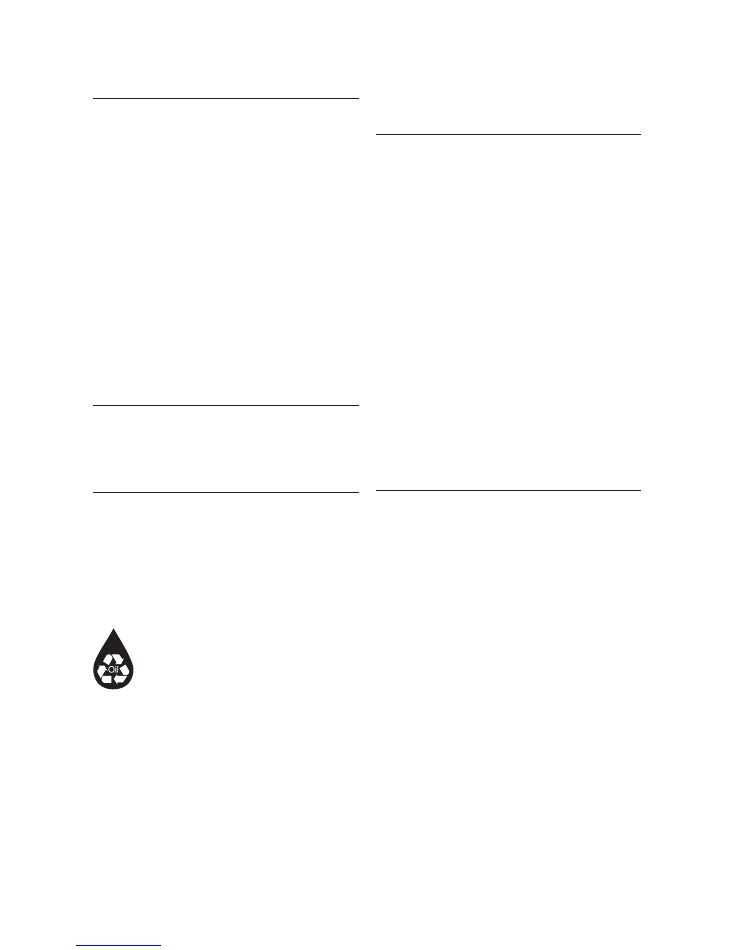
13
O–Ring Maintenance
Through the normal operation of your pressure
washer, o–rings are used to keep the connections of
the hoses and spray gun tight and leak–free. These
o-rings may become worn or damaged.
An O–Ring Maintenance Kit is provided with your
pressure washer which includes replacement
o-rings, rubber washer and water inlet filter. Refer to
the instruction sheet provided in the kit to service
your unit’s o-rings. Note that you will not use all of
the parts in the kit.
To remove a worn or damaged o–ring; use a small
flathead screwdriver to get underneath the o-ring
and pry it off.
WARNING: The high pressure stream of water that
this equipment produces can pierce skin and its
underlying tissues, leading to serious injury and
possible amputation.
• NEVER repair leaking connections with sealant of
any kind. Replace o-ring or seal.
Pump Maintenance
This model does not require any pump
maintenance. The pump is pre-lubricated and
sealed, requiring no additional lubrication for the life
of the pump.
Engine Maintenance
See the engine operator’s manual for instructions on
how to properly maintain the engine.
CAUTION: Avoid prolonged or repeated skin contact
with used motor oil.
• Used motor oil has been shown to cause skin
cancer in certain laboratory animals.
• Thoroughly wash exposed areas with soap and
water.
KEEP OUT OF REACH OF CHILDREN.
DON'T POLLUTE. CONSERVE
RESOURCES. RETURN USED OIL TO
COLLECTION CENTERS.
VII - STORAGE
Preparing Unit for Storage
Water should not remain in the unit for long periods
of time. Sediments or minerals can deposit on pump
parts and “freeze” pump action. If you do not plan to
use the pressure washer for more than 30 days,
follow this procedure:
1. Flush detergent siphoning tube by placing the
filter into a pail of clean water while running
pressure washer in low pressure mode. Flush
for one to two minutes.
2. Shut off the engine and let it cool, then remove
all hoses. Disconnect spark plug wire from spark
plug.
3. Empty the pump of all pumped liquids by pulling
the recoil handle about 6 times. This should
remove most of the liquid in the pump.
4. Draw RV antifreeze (non-alcohol) into the pump
by pouring the solution into a 1 M (3 FT) section
of garden hose connected to inlet adapter and
pulling recoil handle twice.
If available, use PumpSaver in place of RV
antifreeze and follow package instructions.
5. Store unit in a clean, dry area.
Storing the Engine
See the engine operator’s manual for instructions on
how to properly prepare the engine for storage.
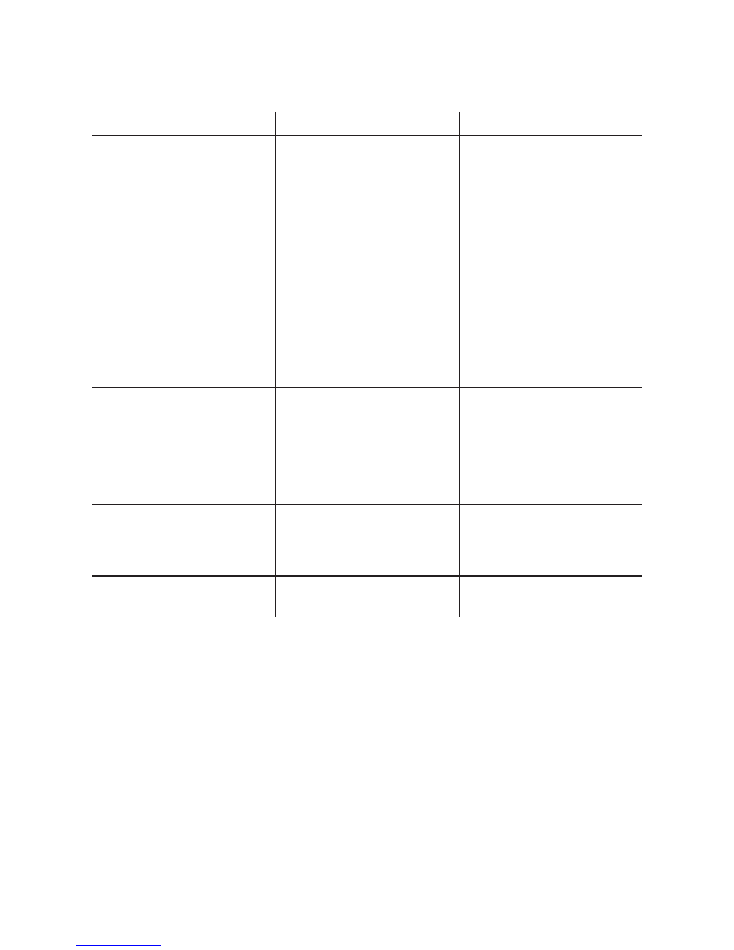
14
VIII - TROUBLESHOOTING
Problem
Cause
Correction
Pump has following problems:
failure to produce pressure,
erratic pressure, chattering, loss
of pressure, low water volume.
1. Nozzle in low pressure mode.
2. Water inlet is blocked.
3. Inadequate water supply.
4. Inlet hose is kinked or leaking.
5. Clogged inlet hose strainer.
6. Water supply is over 37°C
(100°F)
7. High pressure hose is blocked
or leaks.
8. Gun leaks.
9. Orifice is obstructed.
10. Pump is faulty.
1. Pull nozzle backward for high
pressure mode.
2. Clear inlet.
3. Provide adequate water flow.
4. Straighten inlet hose, patch
leak.
5. Check and clean inlet hose
strainer.
6. Provide cooler water supply.
7. Clear blocks in outlet hose.
8. Replace gun.
9. Clean orifice.
10. Contact local service facility.
Detergent fails to mix with spray.
1. Detergent siphoning tube is not
submerged.
2. Chemical filter is clogged or
cracked.
3. Dirty in-line filter.
4. Nozzle is in high pressure
mode.
1. Insert detergent siphoning tube
into detergent.
2. Clean or replace
filter/detergent siphoning tube.
3. See "Check In-Line Filter".
4. Push nozzle forward for low
pressure mode.
Engine runs good at no-load but
"bogs" when load is added.
Engine speed is too slow.
Move throttle control to FAST
position. If engine still "bogs
down", contact Mac Allister service
facility.
Pressure washer stops during
operation.
Out of petrol.
Fill petrol tank.
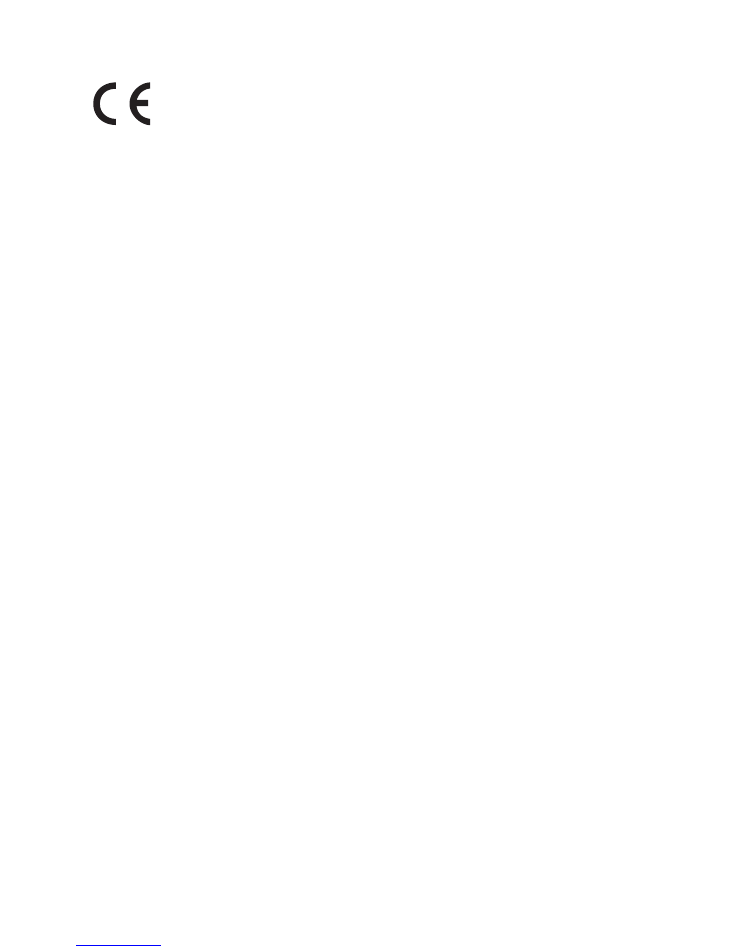
15
E.C DECLARATION OF CONFORMITY
Description: Portable Pressure Washer
Model: MAC3.5PWA
020271
Noise Level*:
Measured LwA: 100 dB(A)/pW
Guaranteed LwA: 100 dB(A)/pW
Sound Pressure Level @ 7 M: 75 dB(A)
The guarantor certifies that the above product meets the requirements of the European Community Law and
can carry the CE mark. The above model complies with the following Directives:
98/37/EC
89/366/EEC
93/68/EEC
2001/14/EC
and related Standards:
EN ISO 14982:1998
ISO 3744:1995
BS EN 55012:2002
Mac Allister Power Tools
1 Hampshire Corporate Park, Chandlers Ford,
Eastleigh, Hants SO53 3YX, U. K.
IX - WARRANTY
1. This product has been manufactured to a high quality standard. It is guaranteed against faulty materials
and workmanship for three years from purchase. Please retain your till receipt as proof of purchase.
2. If the product is found to be defective within the relevant time period, we will either replace all defective
parts or, at our discretion, replace the unit free of charge with the same item or items of a greater value
and/or specification.
3. This guarantee does not cover defects caused by or resulting from:
(a) misuse, abuse or neglect;
(b) trade, professional or hire use;
(c) repairs attempted by anyone other than our authorized repair center (call 0845 300 2577);
or
(d) damage caused by foreign objects, substances or accident.
4. In the unlikely event that this product does develop a fault, please call the Mac Allister helpline at
0845 300 2577.
5. This guarantee is offered in addition to, and does not effect, your statutory rights, which may additionally
enable you to cancel the contract. The warranty is only valid within the UK. The guarantor is MacAllister
Power Tools, 1 Hampshire Corporate Park, Chandlers Ford, Eastleigh, Hants SO53 3YZ, UK.
Mac Allister
is a registered trademark of B&Q P.L.C. It is used under license to Briggs & Stratton Power
Products L.L.C. and is distributed by IP Cleaning SpA.

MacAllister Power Tools
1 Hampshire Corporate Park
Chandlers Ford, Eastleigh
Hants SO53 3YZ, UK
0845 300 2577